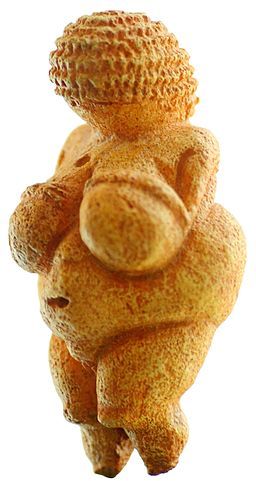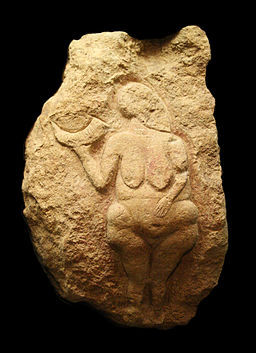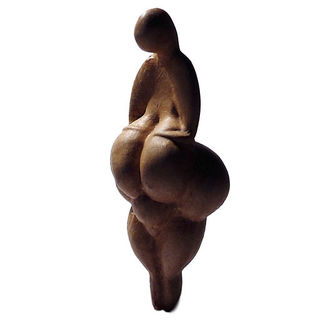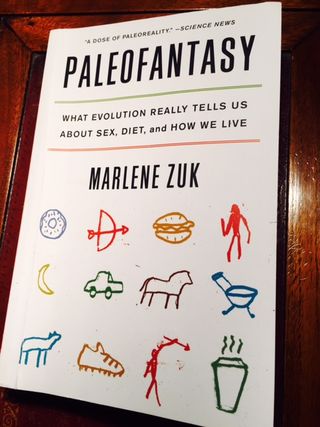Diet
In Nutrition, Where Does Science Stop and Fantasy Begin?
Paleolithic diets: Hardly a "Garden of Earthly Delights."
Posted January 14, 2016

While there are the famous “cave paintings” found in France and Spain, some of the most characteristic art from Paleolithic times depicts obese women. In fact, a photo of the sculpture “Venus of Willendorf” (approximately 29,500 years old, now in the Natural History Museum of Vienna) appears in many books on the history of obesity and indicates “obesity has been known to humans…for more than 20,000 years.” (Bray, An Atlas of Obesity and Weight Control, 2003) These statuettes date from about 40,000 to 10,000 years ago and are called the “Venus” women, possibly because to some archeologists, they may represent fertility symbols, though no one knows their significance. This is an anachronistic designation since Venus was a Roman goddess, and this Paleolithic era is many centuries before the classical times of the ancient Greeks and Romans. Many more than 17 of these figurines, including the Venus of Vestonice and the Venus of Laussel, have been found throughout Europe and the Ukraine and are carved from bone, ivory, wood, soft stone, or clay. They are all massively obese, whether presenting with abdominal obesity or with enormous pendulous breasts and protruding buttocks. These Stone Age figurines are some of the most iconic images of the Paleolithic period. It becomes particularly ironic that the so-called “Paleolithic diet,” then, is touted by some as a particularly healthy one that can prevent obesity and its metabolic abnormalities.

The Paleolithic epoch, often considered synonymous with the Stone Age, spans a vast time period, from roughly 2.6 million years ago until about 10,000 years, with the advent of agriculture and the beginning of the Neolithic period. The first reference to using our Paleolithic ancestors--the hunter-gatherers-- as a model for a contemporary diet came from the 1975 book The Stone Age Diet, by Dr. Walter Voegtlin, a gastroenterologist. (The complete book can be downloaded online.) One of Voegtlin’s most important messages is “There is no such thing as a part-time dieter.” He dedicates his book to those “who can still resist the specious authority of food merchants, their lavish advertisements and spectacular television commercials, and retain sufficient intellectual independence to think for themselves.” His primary focus was on the importance of a carnivorous diet (including eating all the fat around the meat), with a very low percentage of carbohydrates (and no raw vegetables.) Voegtlin believed humans were “strictly carnivorous” until 10,000 years ago, something we now know to be patently false.
The idea of the Paleo diet, though, first appeared in a peer-reviewed journal in 1985 when Eaton and Boyd published their article “Paleolithic Nutrition” in The New England Journal of Medicine. The authors did acknowledge that these early humans demonstrated the considerable “versatility of the omnivore” in that the foods available to them varied widely depending on the specific time within the Paleolithic period, geography, location, and seasonal changes. These ancestors ate meat, including wild game, bison, horses, mammoths, and deer, but the authors acknowledged that it is more difficult to assess their consumption of vegetables since plant material is not as well preserved over the centuries. Even so, Eaton and Boyd believed that this diet could be a “reference standard” for modern nutrition, and they speculated that our modern Western diet contributes to "diseases of civilization," such as diabetes and atherosclerosis.
Interest in a Paleolithic diet has grown considerably over more recent years, as evidenced by articles about the value of a predominantly protein and fat-based diet (in various proportions) in popular magazines such as Science (2008), Scientific American (2013), The Atlantic (2014) and The New Yorker (2014.) On a recent search on barnesandnoble.com, I found over 500 books that now feature some version of what authors consider the Paleo diet. Konner and Eaton revisted “Paleolithic nutrition” 25 years later (Nutrition in Clinical Practice, 2010) The authors maintained “We did not then and do not now propose that Americans adopt a particular diet and lifestyle on the basis of anthropological evidence alone” and instead they called for more research. They acknowledged that our “flexibility in adaptation may have been central to human evolution” but emphasized that they believed the potential dangers of eating meat today were related to the high proportions of both total and saturated fat in commercially available meats.

The problem, though, is that this notion of an “idyllic past”—some imagined food Eden or “Garden of Earthly Delights,” if you will, (to use the title of the famous Hieronymus Bosch painting) is a “fabricated myth,” explain Nesse and Williams in their 1994 book Why We Get Sick. Only to a limited degree can we reconstruct the diet of our Paleolithic ancestors. First, we are dealing with an enormous time span of hundreds of thousands of years that involved humans living in vastly different geographies and climates. There was never “one” Paleolithic way of eating.
The word paleofantasy captures the sentiment of Nesse and Williams exactly. The word was first used by professor of anthropology Dr. Leslie Aiello, president of the Wenner-Gren Foundation for Anthropological Research, in one of her University College of London lectures in the 1990s (personal communication.) For Dr. Aiello, it means quite simply “People’s fantasies about what the past was like,” and it made her think “about where science stops and fantasy begins.”

Dr. Marlene Zuk, a professor of ecology, evolution, and behavior, has borrowed the concept directly from Dr. Aiello in her book Paleofantasy: What Evolution Really Tells Us about Sex, Diet, and How We Live (2013). Zuk explains, “Neither we nor any other species have ever been a seamless match with the environment. Instead, our adaptation is more like a broken zipper, with some teeth that align and others that gape apart.” She notes that the concept of paleofantasy implies that we humans, “were at some point perfectly adapted to our environments.” It reflects an “erroneous idea” and “misunderstanding” about how evolution works. Zuk notes that Homo sapiens (i.e. “anatomically modern humans”) appeared about 100,000 years ago, but there was never a single lifestyle “any more than there is a single Modern lifestyle.”
How do researchers attempt to reconstruct the diet of our Paleolithic forbearers? They seek out clues from remains from archeological sites that have human bones and teeth. For example, Zuk notes that researchers have “studied the plaque clinging to the teeth” (“which has survived in our pre-flossing days”) of these early humans and found evidence of seeds, date palms, and other plants, as well as gelatinized starch grains indicating these people may have harvested grain and cooked their food, “all of which calls into question the various forms of the so-called Paleo diet.” Furthermore, they do studies of carbon isotopes that can distinguish different paths of photosynthesis, particularly in tooth enamel and to a certain extent, in bone collagen although collagen is not preserved beyond 200,000 years. (Kuipers et al, Nutrition Research Reviews, 2012) Researchers also seek out evidence from the few hunter-gatherer populations still in existence, such as the !Kung or the Maasai of Africa or primitive tribes in Australia, but even these populations are vastly different, depending again on their locale and climate. Kuipers et al (2012) also make the point that hunting “leaves the most prominent signature in the archeological record.” As a result, the importance of big game hunting as a food source may be “exaggerated” in these fictionalized accounts of Paleolithic life (Nesse and Williams, 2003) and in all likelihood protein sources could also have come from gathered nuts, tubers, and small animals. (Kuipers et al, 2012)

Hieronymus Bosch's "The Garden of Earthly Delights," 16th Century; left panel of the Garden of Eden; Paleolithic diets have been idealized in ways that reflect a misunderstanding of evolution and what Dr. Leslie Aiello calls "paleofantasy." Bosch's painting is in the Prado Museum in Madrid.
Zuk asks, “Even if we wanted to have a more paleo-diet, could we?” The answer is no. Virtually all of the foods available to us today are vastly different from those eaten in Stone Age times. Many of those foods, for example, are now extinct, such as the woolly mammoths. And a white-tailed deer has 2.2 grams of fat while extra lean ground beef has 18.5 grams of fat. Nesse and Williams explain, “We would find most of the game strong-tasting and extremely tough” and quite “tedious” to prepare the carcass for consumption. Even ripe wild fruits would be sour or bitter to our tastes.
The issue is not so much whether the Paleolithic diet is efficacious, though there are small short-term studies such as the recent ones by either Masharani et al (European Journal Clinical Nutrition, 2015) or by Bligh et al (British Journal of Nutrition, 2015) on metabolic health benefits of a Paleolithic-style diet. Zuk herself emphasizes that her focus, though, was not on comparing Paleo diets with others but rather whether a contemporary version really could possibly replicate what our Stone Age ancestors actually ate.
In a comprehensive review of various diets, Katz and Meller (Annual Review of Public Health, 2014) note there have never been any rigorous, long-term comparative studies that use methodology that is completely free from bias and confounding. In the absence of such, say Katz and Meller, it is “not so much evidence of absent benefits but a relative lack of evidence.” A pattern of eating that avoids highly processed foods and an excessive intake of sugar, while increasing our intake of vegetables, fruits, nuts and seeds, and lean meats, certainly makes sense but calling this some kind of precise replication of Stone Age diet does not. Rather, we should focus more on “guiding principles.” Say Katz and Meller, “Claims for the established superiority of any one specific diet over others are exaggerated,” and they add, “We need less debate about what diet is good for health.” Instead, we should be more attuned to public health issues of how to get people “in the direction of optimal eating.”




